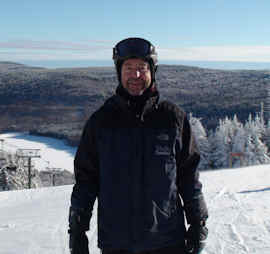Hello Everyone –
 Let’s jump back to my first column of this season in December. At that time I let you know what five of the leading meteorologists in the region thought about what the weather was going to be this season. All agreed that due to the La Nina occurring this winter, things would start off cold and snowy and then turn milder.
Let’s jump back to my first column of this season in December. At that time I let you know what five of the leading meteorologists in the region thought about what the weather was going to be this season. All agreed that due to the La Nina occurring this winter, things would start off cold and snowy and then turn milder.
Well December was cold and snowy everywhere, but I don’t think you can describe January as being mild.
Now that got me to thinking and as my wife Angie usually says, time for me to get in trouble. Well I went back to one of my favorite weather folks, Herb Stevens, The Skiing Weatherman, to find out what he is thinking now about the whole weather situation facing the southeast. So upon further review, here are Herb’s updated thoughts on what has happened and what he thinks is now going to happen.
A winter that started out behaving like one with a moderate La Nina in place deviated from the plan in January and it has continued to operate in a very un-La Nina fashion as we have moved into February. Typically, the heart of a La Nina winter brings about the formation of an upper level ridge in the southeastern U.S., which results in a trend toward milder than normal temperatures from the mid-Atlantic region southward to the Gulf of Mexico. That usually results in a transition of packed powder surfaces to surfaces that are more spring-like in consistency in the resorts of the central and southern Appalachians. Well, January 2011 brought a continuation of the cold and snowy weather of December, and wonderful mid winter conditions have been the rule since Christmas.
What made this La Nina produce weather unlike any La Nina since the winter of 1917-1918? In my opinion, there are several reasons why it has turned out so much colder than previous La Ninas. First, there is the fact that with respect to sunspot activity, the sun is quieter right now than it has been in 200 years. A correlation has been identified by researchers between a quiet sun and a high latitude blocking pattern. Indeed, a blocking pattern over northeastern Canada and the north Atlantic persisted through December and almost all of January, and that sort of pattern supports the positioning of an upper level trough over the eastern U.S. The trough in turn, acts as a receptacle for cold air shots from Canada, and it also supports storm formation along the eastern seaboard. Over the past two months, we have seen plenty of cold and plenty of eastern storminess. Also supportive of the eastern trough is the eruption of 3 high latitude volcanos in the past 24 months. Those volcanos ejected sulfur dioxide into the stratosphere, which for reasons not fully understood, also correlates well with a blocking pattern. Lastly, the global sea surface temperatures have been cooling rather dramatically for the past several months, as have air temperatures around the globe, so the overall backdrop against which this pattern has evolved has been a cold one. The blocking pattern of an upper level ridge over northeastern Canada and the north Atlantic tends to suppress the storm track along the eastern seaboard, which helps to explain the above normal snowfall in the central and southern Appalachians at a time where we might expect mild temps and loose granular snow.
Can it last? Well, the short term answer is yes, as I expect the colder than normal regime to remain in place through the middle of the month. However, the trough over the East has started to retrogress toward the middle of the country, and by the latter stages of this month, I believe it will take up residence over the Pacific Northwest. If you are planning on a trip to the central or northern Rockies in late February/ early March, your timing looks good, as there should be plenty of fresh snow on a regular basis in that part of the country.
Meanwhile, the prototypical La Nina southeastern ridge will finally develop by mid month, and that will turn temperatures milder than normal from the Mason Dixon line southward to the Gulf of Mexico. Snow will be much harder to come by later this month, but thankfully, base depths that were built up by a combination of snowmaking and natural snow should be able to sustain the season into March without too much trouble. One last point about La Ninas…typical ones, that is…the relative warmth of later this month will be a "false spring", with colder air and snow returning to the mountains in early March, which should help get this meteorologically anomalous winter to the finish line.
Did you get that? Just thought you would like to know.
That’s it for this week, just remember whether it be cold or whether it be hot, we’ll weather the weather, whatever the weather will be. Think about it! See you on the slopes sometime soon, I hope.
Send your comments to: [email protected]
Joe Stevens, a member of the southeast ski industry since 1990 is a regular columnist for skisoutheast.com and serves as the Communications Director for the West Virginia Ski Areas Association.
